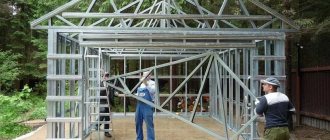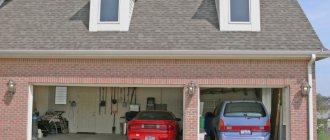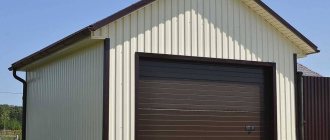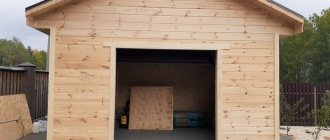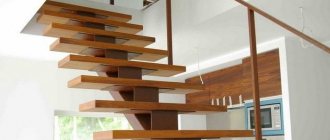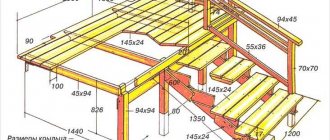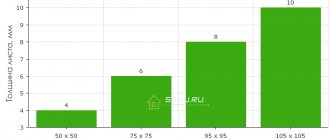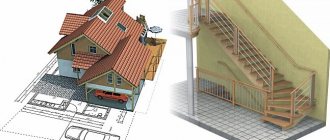16340 0 9
Vadim September 4, 2016
A warm garage is the longed-for dream of any motorist. At one time, I was as happy as a child when I managed to acquire a good, as it seemed to me at that time, metal garage. But it soon became clear that in the off-season it becomes damp, and in winter it only protects from the wind. Therefore, the question of insulation arose quite quickly. I decided to devote this material to how to insulate a metal garage with my own hands. In it I will talk about my own experience and talk about what advice various specialists gave me.
Classic iron garage.
According to SNiP 21.02-99, for comfortable storage of cars and trucks and starting the engine without preliminary preparation, the temperature in the box (garage) should not fall below +5ºС, and this figure should be used as a starting point.
Why insulate walls
The enclosing structures of buildings for cars are made of large-block materials, for example, cinder block or gas block, less often of brick.
Depending on the method of laying the products, the thickness of such walls will range from 12 to 30 centimeters. This width is not enough to protect the room from the penetration of cold air. Even when installing a heating system, the difference between the air temperature outside and inside the building will lead to condensation. There is no need to artificially increase the temperature in the garage to high levels. After a car enters a warm room from a cold street, condensation will certainly appear on its surface, which will lead to corrosion of the metal. Thermal insulation of the garage should be selected and installed in such a way that the difference in temperature in the room and outside the window is minimal. The optimal performance for a car is considered to be +5 degrees.
Note! When insulating building envelopes, motorists seal all cracks, including ventilation holes. It is prohibited to clog exhaust pipes; they are used to remove accumulated moisture and help remove carbon monoxide from the room.
Preparation
When dealing with the internal cladding of metal structures, first of all you should take care of anti-corrosion. If there is rust on the surface of the walls, it should be removed with a special metal brush. If necessary, patch repairs of individual areas are carried out. After which the surface is treated with an anti-corrosion solution.
To ensure optimal indoor conditions, you also need to create a ventilation system. It will be needed for circulation: the system will remove exhaust air, replacing it with fresh air. Otherwise, accumulated heavy vapors and gases can cause condensation. Condensation negatively affects the condition of the supporting structure of the garage, the car and stored products.
After applying the anti-corrosion solution, it usually takes several days for it to dry completely. Then they begin to insulate the box from the inside. This kind of work can be done with your own hands. According to the rules, first the walls are insulated, then the roof, gates, and only then, if necessary, the protection of the floor is strengthened.
What material to use for this?
In fact, the question here will be solely in the budget allocated for the event. If savings are needed, then there is only one option - polystyrene foam. If you have a little more money, then mineral wool is the optimal solution. Exotic sprayed polyurethane foam will surpass the main types of thermal insulators in properties and efficiency, but it will be the most expensive option and, besides, you won’t be able to create such thermal protection with your own hands; you need to have certain knowledge of the technology, as well as special equipment. Therefore, there are few options:
The last option, as already mentioned, is too expensive and it is not easy to implement such insulation, even with the necessary knowledge and tools. Therefore, we will consider the most affordable and simple types of thermal insulation.
What materials are suitable for insulating a garage?
Mineral wool
An important advantage of using mineral wool to insulate a garage with your own hands is the ability to create a “breathable” insulation layer. The fibrous structure of the cotton wool does not interfere with the natural circulation of air inside the garage; exhaust gases, evaporation of fuel and other technical liquids, which are always stored in abundance on the shelves, will quickly erode outside without stagnating or poisoning the air. An additional argument in favor of cotton wool can be its non-flammability. In a garage where there is a lot of flammable stuff, this can be a deciding factor.
Among all the variety, it is recommended to choose basalt or stone wool. It has the best thermal conductivity of 0.03-0.1 W/m °C and at the same time serves as excellent sound insulation.
The easiest way to lay mineral wool is in the form of semi-rigid mats. The mats fit tightly into the spacer of the frame mounted from timber or galvanized profile on the internal surfaces of the garage: walls, ceiling, gates
And don’t forget that in order for mineral wool to preserve its thermal insulation properties, it is important to use a vapor barrier membrane that will remove excess condensation and prevent moisture from accumulating inside the insulation
Styrofoam
Polystyrene foam is perhaps the most popular material for do-it-yourself garage insulation. It can be cut and processed without problems using simple tools, such as a knife. It has extremely low thermal conductivity - only 0.03-0.04 W/m °C. And it's cheap.
Although there were some downsides. Polystyrene foam noticeably “eats” the internal space and is also flammable; it is better to keep a fire extinguisher in a visible place.
You can mount foam sheets on internal surfaces using polystyrene glue, polyurethane foam or plastic dowels (they will require sheathing). The optimal thickness of the insulating layer is 50-100 mm. The joints must be sealed with polyurethane foam.
Thermal insulation plaster
In addition to the binder element, gypsum or cement, such plaster contains porous materials - quartz sand, vermiculite or expanded polystyrene, which provide heat-insulating properties. Thermal conductivity coefficient of “warm” plaster: 0.065 to 0.13 W/m °C.
Heat-insulating plaster is applied to the walls and ceiling using standard technology: installing beacons, preparing the mixture, applying the mixture to the surface, leveling. It is recommended to apply one or two layers up to 50 mm thick on the walls, and one layer of 5-30 mm on the ceiling.
It is best to use insulating plaster for garages made of brick or cinder blocks. It will insulate the room and allow you to level the walls and ceiling.
Thermal insulation paint
Thermal insulation paint is a new word in room insulation. It is a polymer composite filled with hollow ceramic microspheres.
Read more about the structure and features of thermal insulation paint in the article All about ultra-thin ceramic thermal insulation
The thermal conductivity of the paint is about 0.065 W/m °C, which is approximately comparable to “warm” plaster. Only the insulation layer will be only 2-4 mm. What a saving of internal space.
In its finished form, the insulation is a liquid consistency, which is applied like regular paint, using a brush, roller or spray gun. This method of application will be especially appreciated by owners of metal garages. After all, the internal surfaces of such garages have a complex profile due to various corners, beams and protruding fasteners, and it is quite difficult to attach a tight-fitting layer of insulation to them. But painting the surface of any profile, no matter how complex, is not difficult.
However, it would be a mistake to assume that a thin layer of heat-insulating paint will create the desired microclimate in the garage. Yes, it can replace a fairly thick layer of traditional insulation. But for the desired result - +5°C inside the garage - you will still need to supplement it with a layer of another insulation, mineral wool or polystyrene foam.
Foam insulation
Foam insulation has the structure of polyurethane foam:
- Manufacturers of the material assure that the service life of the insulation is up to 50 years or longer. Very durable insulating material. The foam is durable and slightly inferior in thermal insulation properties to penoplex;
- This method has its disadvantages - the high cost of the material. To install thermal insulation, you need a specialist with expensive equipment for distributing foam;
- In principle, it is the same polystyrene foam, only in a cylinder. It has the advantage of seamless installation.
Polyurethane foam is not used as the main insulation due to its high cost; it is used to treat joints of tile insulation (foam plastic, polystyrene foam)
Why do you need to insulate your garage?
The temperature regime that has a positive effect on the condition of the car differs significantly from the one in which a person is comfortable. If in residential premises the standard is to maintain the air temperature at +20-22 degrees Celsius, then for storing a car +5 degrees is considered the most optimal. At this temperature, almost no condensation forms on metal parts, causing destructive corrosion.
Therefore, to create a microclimate suitable for technology in the garage, other approaches to insulation are used. After all, the desire to recreate room conditions in the garage using insulation and heating devices will harm the vehicle. For example, in winter, when entering a heated room from the cold, the car will instantly fog up, the air humidity will increase, and the car will sit in such a warm-humid fog all night.
How to properly insulate a garage? Let's figure it out.
Basic requirements for insulation coating
Cars do not tolerate prolonged exposure to moisture well. Because of this, the metal (mainly the body) becomes corroded. If the car is stored in an unheated garage, insulation under the roof will be required to prevent condensation.
Insulation materials used for these purposes must meet the following requirements:
- increased resistance to flame;
- should not absorb vapors emitted by chemicals (car oils, gasoline, etc.);
- are not able to accumulate moisture;
- light weight;
- long service life;
- resistant to mold and fungi.
The roofing material should provide comfortable conditions inside the garage throughout the year, regardless of the temperature and humidity level of the environment.
Types of thermal insulation materials for garage walls
In the modern construction market there is a huge selection of insulation materials. Let's consider the characteristics of the most popular thermal insulation materials:
- Mineral wool is supplied to stores in the form of rigid mats with a density of up to 240 kg/m3. Such products are characterized by high resistance to fire and allow water vapor to pass through their structure (breathe). The only disadvantage of using basalt wool is the need to install a vapor barrier film, which will protect the product from getting wet. When exposed to moisture, the insulation loses its properties.
- Glass wool is considered a cheaper analogue of mineral wool. Such products consist of hard and prickly fibers, so you need to wear glasses and gloves when working with insulation. After getting wet, the mats clump and become heavy, so glass wool needs to be protected from moisture penetration by laying special films or foil.
- Polystyrene foam is considered the most convenient thermal insulation material to use. The products are not afraid of dampness, can be easily cut into pieces with a regular hacksaw, and are affordable. Insulation of a garage can be done using an analogue of polystyrene foam, polystyrene foam, which will last up to 40 years. The main disadvantages of the products in question are considered to be flammability and low resistance to sunlight. Foam plastic unprotected by plaster turns yellow and crumbles.
- Another insulation for the garage, warm plaster consists of vermiculite or foam balls. Such materials have good heat-insulating qualities, but to obtain maximum effect, a thick layer of mortar must be applied to the walls.
Polyurethane foam for garage insulation
And a few words about polyurethane foam, the thermal conductivity of which is 0.019 W/m K. That is, it is better than polystyrene foam. But it is more expensive and requires special equipment to apply it. Until recently, such equipment consisted of huge containers and a compressor. Today, manufacturers offer compact devices whose weight does not exceed 30 kg.
These are two cylinders and a mini-compressor with hoses and nozzles. The cylinders contain two components that are connected and supplied through hoses under pressure
The applied layer is thin (15-20 mm), please note - it is continuous, without seams or joints, and is more effective than many modern thermal insulation materials used for insulating garages. But if we compare the cost, then it is inferior to the same polystyrene foam
Although good insulation cannot be cheap.
Insulation of a metal garage with polyurethane foam
There are several effective and inexpensive technologies for insulating iron garages. But, as practice shows, polystyrene foam is most often used if the conversation turns to DIY processes. There are no restrictions or contraindications in the use of this material. At the same time, the insulation has a number of good technical characteristics, plus the low price of the product itself.
How to insulate garage doors
Not everyone knows how to properly insulate a garage from the inside. Effective and reliable thermal insulation of walls will not be enough, because a significant amount of heat escapes through the gate. The lack of insulation in this design will not allow the garage to warm up to the required temperature levels. At the initial stage of work, a hole is made in one of the doors and the doors are inserted. To reduce heat loss, a curtain made of thick fabric is fixed in this place.
A transparent polyethylene film with a minimum thickness of 0.8 millimeters will help to insulate the entire plane of the gate. This material is cut into strips 20-30 centimeters wide and fixed above the opening, so that the lower edge does not reach the floor surface by 1-2 centimeters. The strips are secured to a wooden beam using staplers. This insulation is very effective - when entering the garage, the driver will see the surrounding space. In addition, narrow strips of polyethylene will smoothly flow around the car and return to their original position.
Some car enthusiasts insulate the inside of their garage doors with polystyrene foam. To do this, a sheathing of wooden blocks is installed on the inside of the structure and the voids are filled with polystyrene foam slabs. To prevent cold air from penetrating through the gaps, the joints of the thermal insulation are taped with tape.
To eliminate drafts entering through the gates, it is necessary to replace the rubber seals. Condensation forms where the thermal insulation comes into contact with the metal surface. To prevent destruction, the steel is treated with paint or other anti-corrosion compound. Waterproofing substances are also applied to other surfaces.
The wooden guide elements of the frame are coated with a primer or heated drying oil, which will protect the material from rotting and exposure to fungus. After laying the foam, the surface is cleaned. Garage doors are finished with OSB boards or thin boards. It is not advisable to use moisture-resistant products for this, for example, gypsum board.
Installation work
Since, according to the laws of physics, heat always escapes through the top, insulation of a metal garage should begin from the ceiling. There are a lot of options for finishing it, in particular, it is quite possible
Ceiling
for the organization of a “false ceiling”. However, this will slightly reduce the usable area of the room.
Ceiling insulation
Also suitable for protection are layers of mineral wool, which should be installed using lathing. In this case, it is better to use an angle profile, bitumen mastic and a special sealant. It should be noted here that experts do not welcome this method due to its technical complexity.
Walls
The type of installation work will depend on the choice of insulation. So, to install thermal insulation using glass or mineral wool, as well as polystyrene foam, you will need a lathing made of wooden slats or metal profiles. The width of its gaps must correspond to the parameters of the layers of the selected insulation. Do not forget about the need to lay a waterproofing film between the surface of the walls, insulation and cladding. It should be understood that insulating a garage with foam plastic requires a layer of heat insulation of at least 3-4 cm.
Insulation of walls with foam plastic
If some thin insulation will be used as finishing, then an adhesive can be used to apply it. And a heat insulator such as polyurethane foam will independently cover all seams and irregularities, since it will cover the surface with a durable crust. However, its application requires special tools, so it is recommended to contact professionals to perform such work.
https://youtube.com/watch?v=BhKWBeN6tes
If the owner's choice fell on heat-insulating paint, then a roller is indispensable. Before purchasing the substance, you will need to make certain calculations, since the consumption looks impressive - about half a liter per 1 m2.
Gates
So, you roughly already know how to insulate a metal garage from the inside. But there is one more point to remember. Namely, about insulating gates, through the cracks of which all the heat evaporates. If in temperate latitudes, in order to reduce heat loss when leaving the garage, it is enough to make a curtain of thick fabric, then in cold regions you cannot do without insulating the gate with insulating sheathing.
Insulating gates with foam plastic
Foam plastic is perfect for these purposes due to its ease of installation. Or hard insulation - polystyrene foam. It is cut into slabs of a given size, after which it is attached to wooden planks, which were prudently placed on the gate. But before this, the iron surface must be covered with a waterproofing film, and the wooden slats with anti-mold mastic. Fastening occurs using adhesive. You should not forget to treat the seams with sealant, and install a rubber gasket along the walls to prevent the cold from blowing in. Then you can begin finishing the insulated surface with some kind of moisture-resistant material. In winter, the drain under the gate is plugged with thick rags.
Floor
Insulating the garage floor with polystyrene foam
The thermal insulation properties of the room can be significantly improved by treating the lower level. In this case, everything will depend on the type of floor surface. As a rule, it is covered with sand-cement screed or iron, which requires appropriate insulation. Since the floor is a fire-hazardous surface, it is recommended to use components that do not contribute to rapid ignition. You will definitely need a primer.
Carrying out insulation work in accordance with the above instructions will ensure the required microclimate for the owner’s car. Strict requirements will ensure not only the safety of the car, but also the comfort of a person being indoors.
And we also know how to get a good workbench!
Insulation of walls from the inside
The choice of insulation, as well as the technology for insulating enclosing structures, will depend on the material from which the enclosing structures are made. Many car enthusiasts are interested in the question of how to insulate a brick garage. First you need to clean the surface from dust and dirt, mount a frame into which the thermal insulation will be installed.
The sheathing is made from a plasterboard profile. The guides are fixed to the wall with dowels, which are driven in every 30 centimeters. The distance between the guides must correspond to the width of the insulation boards. To finish the walls, you can use sheets of plasterboard or asbestos fiber. It is better to use the latest products, because they have a high degree of fire resistance compared to similar materials.
Advice! Asbestos fiber is quite fragile; to prevent its destruction as a result of various mechanical influences, reduce the pitch between the frame guides.
Insulation of garage walls from the inside is carried out using mineral wool or other products made in the form of slabs. In this case, the mats are inserted between the guides, their position is fixed using special hooks. After this, they begin to install the vapor barrier membrane, which should be connected to the cotton wool insulation.
We also insulate the garage from the outside, using warm plaster or special paint. Carrying out such work shifts the dew point, which will protect the walls from moisture penetration and further freezing. The owner of the building must install forced ventilation. This system is designed for intensive air exchange.
Insulating a garage with foam plastic is suitable for insulating metal walls. Expanded polystyrene boards are fixed to the base surface using an adhesive mixture. To securely fix the thermal insulation, it is necessary to first clean and degrease the metal. The sheets are fixed to the walls with the seams aligned, and polyurethane foam is poured into the gaps. Polystyrene foam is subject to combustion, so a thin layer of plaster must be applied to its surface.
Metal garage walls are often insulated with polyurethane foam or special paint. If there are voids between the frame, insulation is carried out using penoizol. The liquid mass penetrates into the wall through special holes. The foam clings well to surrounding surfaces, hardens, turning into high-quality and reliable thermal insulation.
Required Tools
It is advisable to insulate the garage in the warm season, but sometimes the situation forces you to carry out work at sub-zero temperatures. Here there is a need to insulate the box quickly and reliably. To use time efficiently, the following equipment is prepared in advance:
- electric drill;
- mask and gloves (protective);
- welding machine;
- building level;
- screwdriver;
- self-tapping screws;
- metal scissors;
- tape measure from 5 m;
- staples and furniture stapler;
- wooden blocks for the horizontal crossbars of the sheathing;
- steel profile.
If all of the above is present, it’s time to start insulating the garage from the inside.
Design features of the garage that affect the insulation process
The main feature of the garage, which directly affects the insulation technology, is the thin walls and roof. Even garages built from brick or cinder blocks rarely have a wall thickness of more than 25 cm. And the thickness of metal garages is measured in millimeters. Such walls are not able to provide the necessary thermal insulation and require proper insulation.
For comparison, in residential premises the thickness of external brick walls ranges from 51 cm (two-brick masonry) to 64 cm (two-and-a-half brick masonry).
When choosing future insulation and calculating the thickness of its layer, you need to strive to ensure that the temperature inside the garage is maintained just above zero.
Moreover, if installed correctly, the insulating layer will work for the desired result at any time of the year: in winter it will retain heat inside the garage, and in summer it will prevent heating outside. This is achieved due to the so-called thermal inertia, which occurs due to a decrease in the thermal conductivity of surfaces in the direction from outside to inside.
You can create the desired direction of thermal inertia by insulating the garage from the inside. Then, outside in relation to the external atmosphere, there will be a material with higher thermal conductivity - cinder blocks, brickwork or metal, and inside - thermal insulation with low thermal conductivity.
Using lining
In some cases, lining, which is made from coniferous and deciduous trees, is used to cover the outer walls of garages. It is a safe and natural material and has a special tongue-and-groove fastening, which makes it easy to connect the panels to each other.
There are several classes of lining, and the most ideal option is premium class material, which is characterized by excellent quality and a fairly high price, but it does not allow the presence of any defects or flaws on both surfaces. For a garage, you can use class A, which refers to the first grade and allows minor defects while maintaining the normal quality of the panels.
The most popular type recently is eurolining, as it is produced under strict control and meets all established European norms and standards.
How to insulate a cellar in a garage
Insulating a cellar in a garage is technologically not much different from insulating premises for other purposes, but has several important nuances. The main one is increased humidity due to direct contact of the walls and floor of the cellar with the soil. Therefore, waterproofing becomes a key step.
Ideally, it is better to apply a layer of waterproofing to the outer surfaces of the walls, creating an airtight capsule around the cellar. However, in an already built garage or a garage located in a cooperative, it is sometimes impossible to reach the outer surface. In this case, waterproofing is done from the inside.
Polymer films, roll insulation or bitumen mastics can be used as a waterproofing material. The result should be a complete layer of waterproofing. A special vapor-waterproofing membrane is suitable for insulating the ceiling.
Then, insulation is laid on the walls, floor and ceiling: mineral wool, polystyrene foam or extruded polystyrene foam. For mineral wool, you will need to build a frame, and sheets of polystyrene foam are glued to surfaces or secured with plastic dowels with a mushroom cap.
A wooden frame for installing mineral wool must be treated with protective compounds.
The top layer of insulation is covered with a vapor barrier. After which you can begin covering it with decorative materials, for example, plastic panels.
Recommendations for work
When using adhesive to attach the foam, pay attention to the ambient temperature. It is not recommended to carry out work in cold conditions (not lower than - 15 degrees). For 1 sq.
m. foam plastic or polystyrene foam requires 4-5 disc nails. Polyurethane foam can move loose insulation, so try to use it in small quantities. To save space, you can use liquid insulation, such as: foamed polyurethane, insulation, thermos paint and many others. It is easily applied to walls using a roller and brush, as well as special sprayers. But there is one drawback - the environmental side of these materials is very questionable.
When applying liquid insulation, as in the case of rigid foam, it is necessary to install wooden studs for finishing
For spacious garages, installing plasterboard walls is suitable. But remember that this design is the most fragile, in addition, it is necessary to purchase fire-resistant and moisture-resistant plasterboard. This material can also be used when it is necessary to insulate plastic windows.
Do I need to insulate the floor in the garage?
Whether to insulate the garage floor or not is up to everyone to decide for themselves. From the point of view of complete thermal insulation of the internal space, it is of course better to insulate. After all, through a floor laid directly on the ground, cold will always enter in late autumn and winter, disturbing the balance of the microclimate.
On the other hand, insulating the floor of an already built garage can be quite a difficult task. After all, after installing the insulation, the floor level will rise to a height of 10 to 20 cm. At a minimum, this will create problems when driving the car. And at the very least, it will make it impossible to park your car in the garage due to the fact that it will no longer fit through the gate.
Therefore, before you start insulating the floor, you need to carefully measure everything and find out whether there is enough headroom.
Among the options for do-it-yourself garage floor insulation, two main approaches can be distinguished:
- Quick modification of the floor to reduce heat loss.
- Installation of a full layer of insulation.
For the first option, when time, and most importantly finances, are limited, you can cover the garage floor with boards or OSB boards. Of course, this cannot be called serious insulation, but a noticeable effect will still appear. The floor will no longer be cold, and an additional air layer will appear under the flooring, holding back the cold from the base of the floor.
The second option is to fully insulate the floor by creating a multi-layer thermal insulation cake.
Taking into account the fact that the car puts a significant load on the garage floor, extruded polystyrene foam would be the best insulation option.
Floor insulation
If the garage has a cellar for storing canned goods, vegetables and fruits, there is no need for floor insulation. In the absence of such an underground room, insulation is mandatory. The easiest way to insulate the floor is with foam boards. The whole workflow boils down to the following:
- vacuum the base and remove dirt;
- lay roofing material or plastic film on the base;
- we fix sheets of polystyrene foam of maximum density (the thickness of the cake is at least 10 centimeters);
- we lay waterproofing material and reinforcing mesh;
- We install the beacons and fill in the leveling screed.
By following the recommendations given, you can quickly insulate all structural elements of the garage. At the final stage of work, surfaces are painted or finished with the selected material.
Foam plastic and all its analogues
The insulation technology in this case is incredibly simple. It is first necessary to carry out several measures to prepare the work front - treat the walls with antiseptics and prime them. If necessary, degreasing is carried out - for metal surfaces. Next, the foam boards are simply glued to the plane without gaps or cracks. If they do form, then after finishing the work, all existing flaws are filled with polyurethane foam. There is a more complex method for assembling wood sheathing, the same as for mineral wool. The principle of its assembly will be the same in both cases, so you can simply consider it further.
Entrance trim
Insulating walls will not be beneficial if cold air enters through the cracks of the entrance gate or wicket. The situation is easily solved by using rigid insulation such as polystyrene foam. First, the gates are insulated, then the small entrance door to them is insulated. The sequence is:
- The metal surface is treated with protective mastic. Expanded polystyrene is not afraid of moisture, however, when opening the gate, raindrops or snow can get into the cracks between the material and the iron sheet. This should not be allowed.
- Attach lathing profiles along the perimeter of the gate.
- Fix the polystyrene plates to the mounting adhesive; it is advisable to apply penofol (a foil-based material) on top of them.
- Make a wooden sheathing for installation of the cladding. Provide a distance of about 30 mm between the future lining/plasterboard/other cladding material and polystyrene foam, so that there is an air gap.
- Fix the cladding to the sheathing.
- Perform similar actions with the gate.
Mineral wool
Preparation of the base for insulation is carried out similarly to the previous option, but insulation of the garage walls from the inside in this case will differ in technology. First, you should assemble the sheathing from wood or metal parts. Usually, these are familiar profiles intended for installation of gypsum plasterboard structures. The installation step of the elements almost corresponds to the width of a roll of mineral wool or a hard mat made of the same material, but slightly smaller. This way the insulation will be securely fixed in the cells of the frame.
Next, you should take care to protect the insulator from moisture and lay a layer of waterproofing. Rigid mats of cotton wool insulation are placed inside the cells or pieces of rolled wool cut to size are inserted. The resulting structure is covered with a layer of vapor barrier and decorated to your liking. It should be taken into account that mineral wool will completely lose its properties when it gets wet and protect it as best as possible from water.


